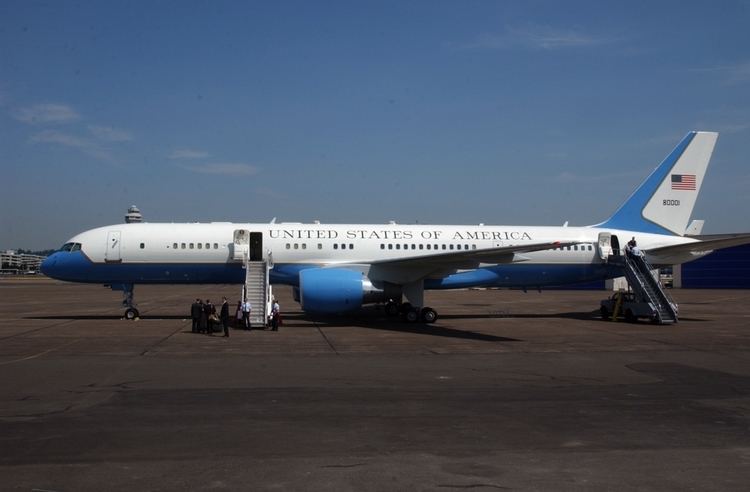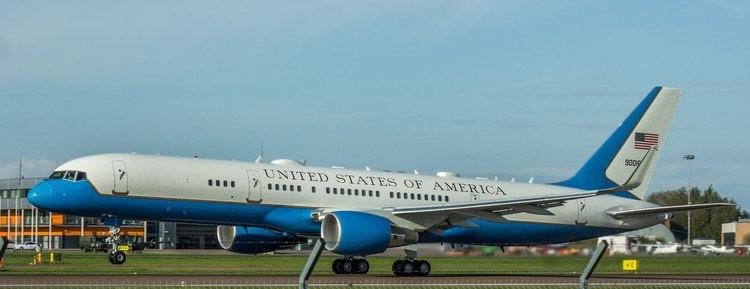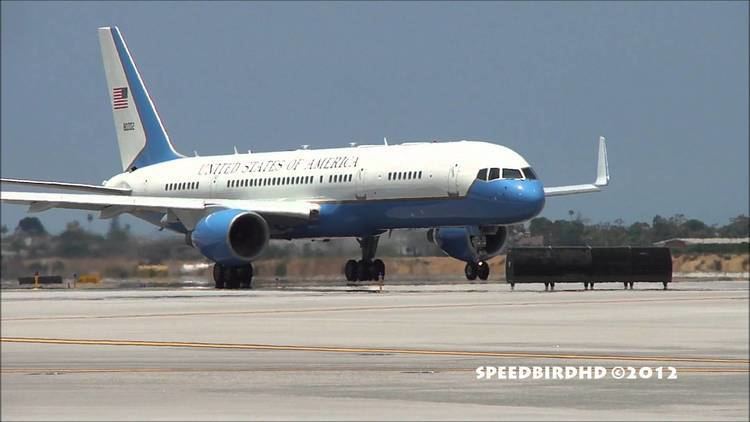Top speed 968 km/h Length 47 m Cruise speed 837 km/h Manufacturer Boeing | Range 11,100 km Wingspan 38 m Engine type Pratt & Whitney PW2000 | |
 | ||
The Boeing C-32 is a military passenger transportation version of the Boeing 757 for the United States Air Force. The C-32 provides transportation for United States leaders to locations around the world. The primary users are the Vice President of the United States, using the distinctive call sign "Air Force Two", the First Lady and the Secretary of State. On rare occasions, other members of the U.S. Cabinet and Congressional leaders have been authorized to fly aboard the C-32 for various missions. The C-32, since its debut, has also served as Air Force One in place of the larger VC-25A to airports that cannot support the Boeing 747-based jumbo jet.
Contents
- Boeing c 32 landing joint base andrews
- Development and operation
- Design
- Operators
- Specifications C 32A
- References

Boeing c 32 landing joint base andrews
Development and operation

The C-32 is a military version of the Boeing 757-200 extended range aircraft, selected along with the C-37A to replace the aging fleet of VC-137 aircraft. Active-duty aircrews from the 1st Airlift Squadron, 89th Airlift Wing at Andrews Air Force Base, Maryland, fly the aircraft.

The contract was awarded for the C-32 in August 1996. By using commercial off-the-shelf acquisition practices, a new record was set from contract award to aircraft delivery: less than two years. The C-32 was the first military aircraft ever acquired in this manner. The 89th Airlift Wing acquired the first of four aircraft in late June 1998. A further two were acquired in 2010, with both having been used previously as commercial aircraft.

The 227th Special Operations Flight at McGuire Air Force Base, N.J., has two modified C-32B aircraft supporting specialist worldwide airlift operations (c/n 25493 & 25494). They are known to be operated by the 486th Flight Test Squadron located at Eglin Air Force Base, Florida. These are the only U.S Air Force C-32B in existence although both aircraft have been associated with a multiplicity of registrations. These 757s are fitted with a generic (non-VIP) interior and 48 comfortable seats, and unlike the C-32A, are equipped with aerial refueling equipment and Rolls-Royce RB211 engines. All luggage and cargo must be fitted into the rear of the main cabin (except for a small lower cargo hold that contains spare tires/wheels along with oil and hydraulic servicing units), the forward and aft lower cargo areas housing extended range fuel cells giving them a 6,000 nmi (6,900 mi; 11,000 km) range (the longest range of any 757 in operation). They have frequently been associated with the Foreign Emergency Support Team of the U.S. State Department.
Design

The C-32 is a specially configured version of the Boeing 757-200 airliner. The C-32 body is identical to that of the Boeing 757-200, but has different interior furnishings and more sophisticated avionics. For the C-32A, the passenger cabin is divided into four sections:


The C-32 is more fuel efficient and has improved capabilities over its VC-137 predecessor. It can travel twice the distance on the same amount of fuel and operate on shorter runways down to 5,000 feet (1,500 m) in length. Its 92,000-pound (42,000 kg) fuel capacity allows the aircraft to travel 5,500 nautical miles (10,200 km; 6,300 mi) unrefueled. In-flight refueling is via a receptacle on top of the forward fuselage, just aft of the cockpit.
Heading the safety equipment list is the Traffic Collision Avoidance System and Enhanced Ground Proximity Warning System. Weather systems are enhanced with a Predictive Windshear Warning System. Other items include the future air navigation system with Global Positioning System, Flight Management System/Electronic Flight Instrument System, Controller Pilot Data Link Communications and Automatic Dependent Surveillance.
Inside the C-32, communications are paramount. The Vice President, heads of state and other decision-makers can conduct business anywhere around the world using improved telephones, satellites, television monitors, facsimiles and copy machines. The C-32 has state-of-the-art avionics equipment.
The six C-32A aircraft have blended winglets added by Goodrich Aviation Technical Services in Everett, Washington.
The C-32 has better short-field capacity than the VC-25, making it preferable when flying to locations without a runway long enough to accommodate the VC-25.
Operators
United States Air Force
Air Mobility Command
Air Force Special Operations Command
Specifications (C-32A)
Data from
General characteristics
Performance
